Is Breguet Ready for a Comeback? And if so, How?
by Raman Kalra
Not many brands can boast the incredible depth of history of Breguet. It is one of the oldest watchmaking brands surviving today, established in 1775 by Abraham-Louis Breguet.
Fast-forward to today and Breguet is under the Swatch Group umbrella, being bought by the group in 1999, sitting at the top end of what they offer.
Within its extensive history, Breguet holds a claim to many innovations within the watchmaking industry. These include the coveted tourbillon complication, the basis of the modern chronograph, and even a specific hand design that is named after the brand.
Notably, buying into all that heritage is still possibile today.
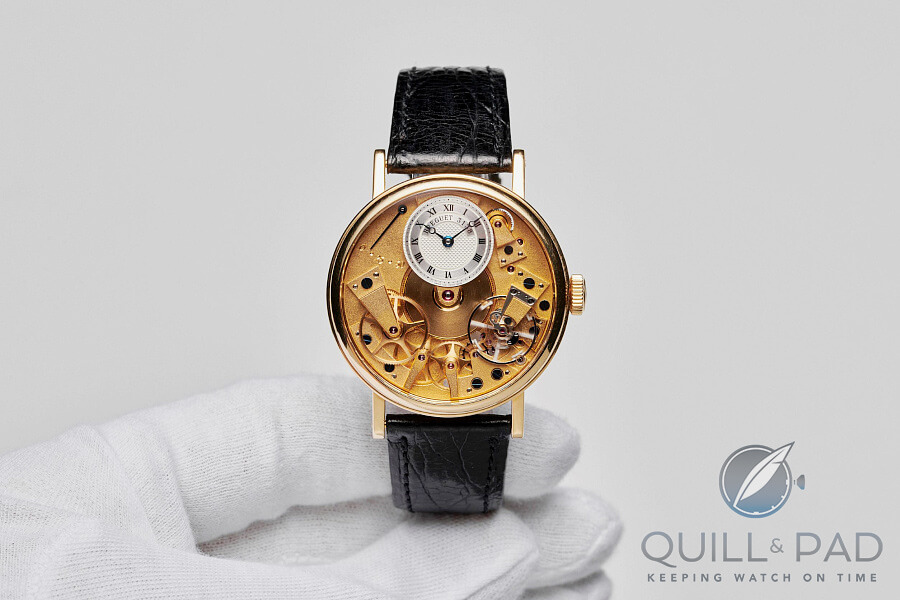
Breguet La Tradition (photo courtesy Ineichen auctions)
In a world where other brands of similar stature have exploded in popularity, Breguet has been somewhat left behind. I believe that should change. Would it increase interest, demand, and prices, making them (even) less accessible to me personally? Yes, but sometimes you need to give attention to those who deserve it, and Breguet certainly does.
Further, is there a reason it has yet to experience broader interest, and are we about to see the tide shift for Breguet?
As I write this in May 2023, there are some incredible deals to be had on second-hand Breguet pieces, making them an extremely attractive option for those looking to stand out from the crowd.
History of Breguet
Typically, I start by covering the background of a specific watch or brand. Heritage and history are important factors when it comes to watches, especially as they are emotive products. A lot of what we see today can be explained by where a brand came from and its’ philosophy.
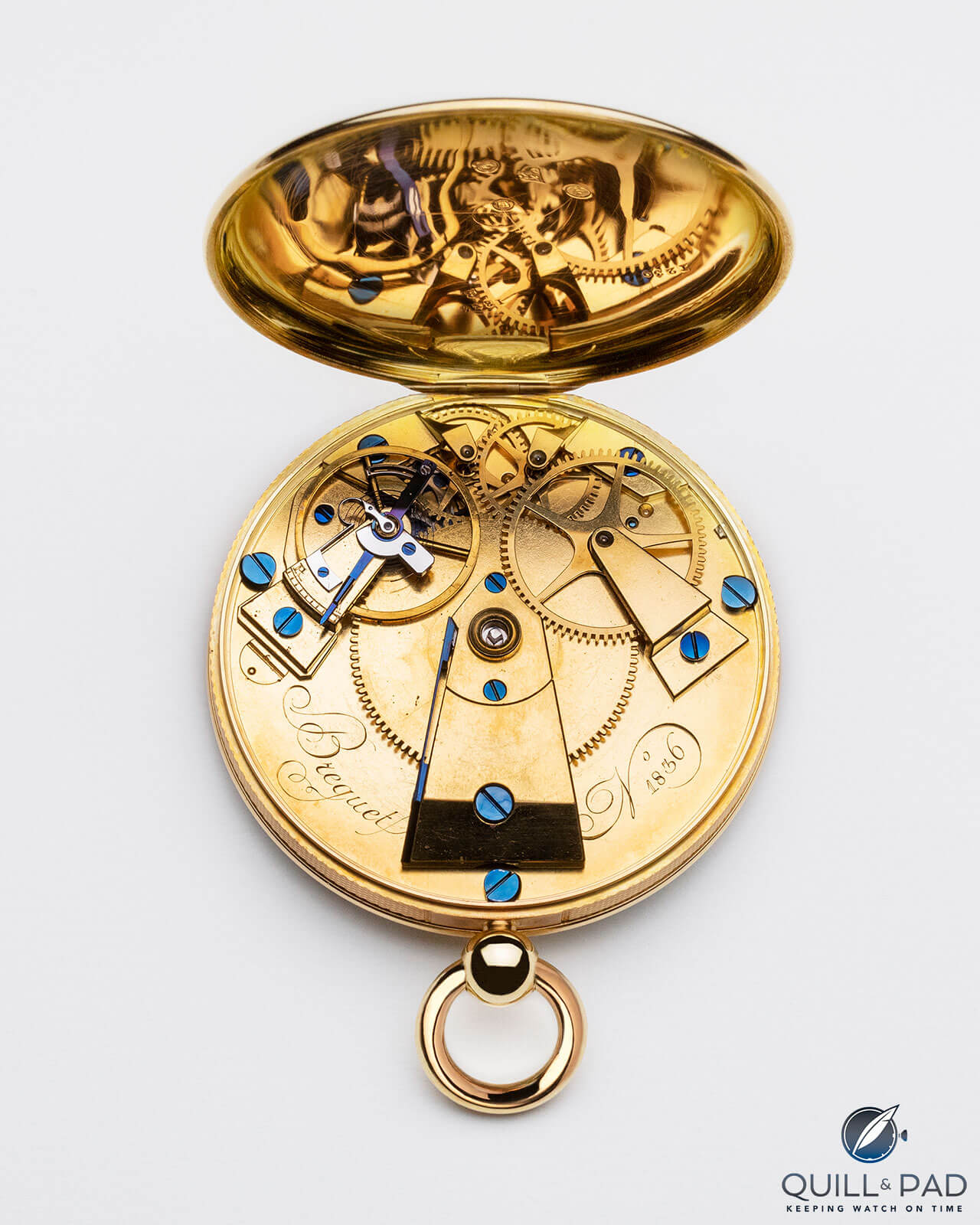
Movement of the Abraham-Louis Breguet Souscription Pocket Watch No. 1836 From 1807
However, discussing the watches in the present is impossible without looking at their past when covering Breguet. Breguet has one of the richest histories in watchmaking, founded in 1775 by Abraham-Louis Breguet in Paris.
To provide some context, only two other brands can say they are older – Blancpain (1735) and Vacheron Constantin (1755) – and Breguet was established a full 64 years before Patek Philippe, 99 years before Piaget and 130 years before Rolex.
Covering Breguet without looking at its history is hard, so bear with me. I will attempt to cut it down to the most relevant areas.

Abraham-Louis Breguet portrait
There has been a lot of coverage of the life of Abraham-Louis Breguet, so I will jump straight to the relevant aspects that led to the rise of the Breguet brand. Abraham-Louis Breguet had been surrounded by the profession from a young age thanks to his stepfather who came from a family of watchmakers. Breguet took an interest and went on to complete apprenticeships around Versailles. It was his studies of Mathematics at Collège Mazarin under Abbé Marie that would open the doors for Breguet to become a future success.
Abbé Marie was quickly impressed by the intelligence of Abraham-Louis and arranged for him to be introduced to King Louis XVI, leading to royal commissions early on for Breguet.
It started with the self-winding pocket watch Breguet called the Perpétuelle in 1780. Others were producing similar concepts, but none performed reliably like the Perpétuelle, which used an oscillating platinum weight, bringing Breguet recognition across Europe.
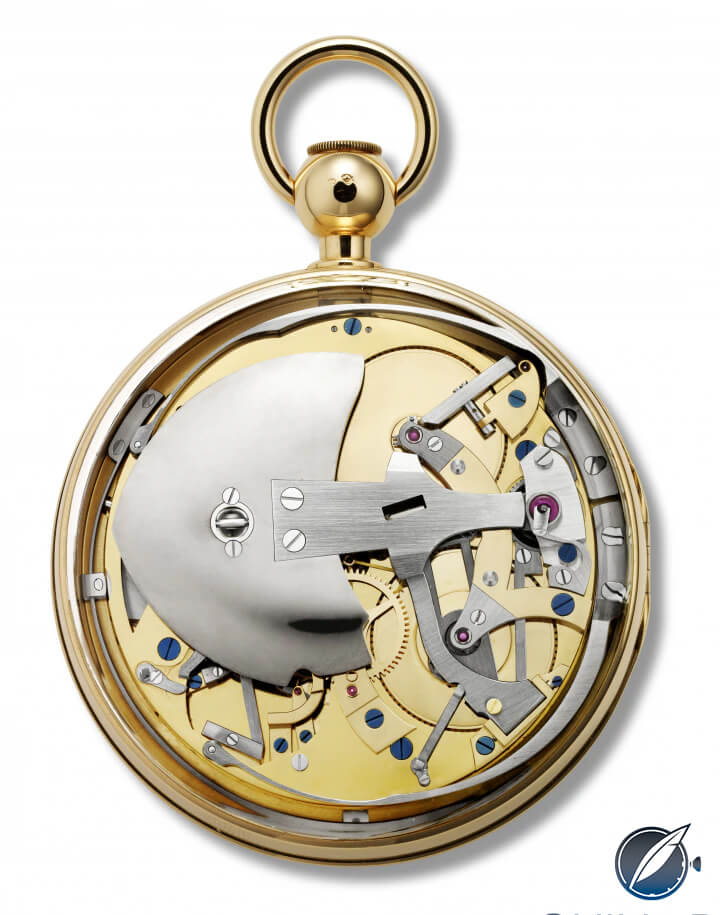
Winding rotor on the back of the Breguet Ref. 1160, which is a modern replica of the “Marie-Antoinette” watch from 1827
This was just the start of what Breguet would go on to invent. A few years later, in 1783, saw the introduction of the gong-spring for repeating watches, replacing bells, and reducing the thickness of the product. In that same year, Breguet debuted the open-tipped Breguet hands that became popular very quickly, leading other brands to follow.
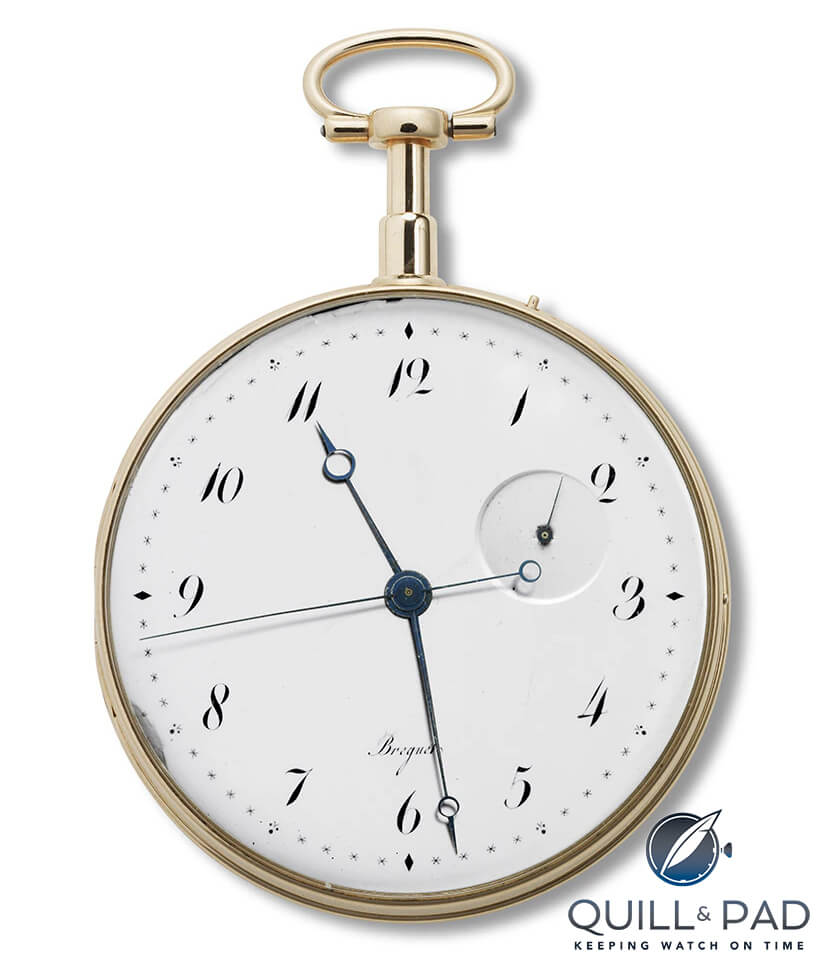
Breguet pocket watch from 1783 already featuring the now iconic numerals and hands
In 1786, Breguet began using guilloche finishing on the dials. The allure of the dial finishing came down to not just the pleasant aesthetics, but also the added functionality. Compared to the enamel dials otherwise used, guilloche finishing allowed for different patterns to be engraved into the dial that looks attractive but also gave better protection as scratches were less visible, the fine grooves rapped dust, and the matte look offered improved legibility.
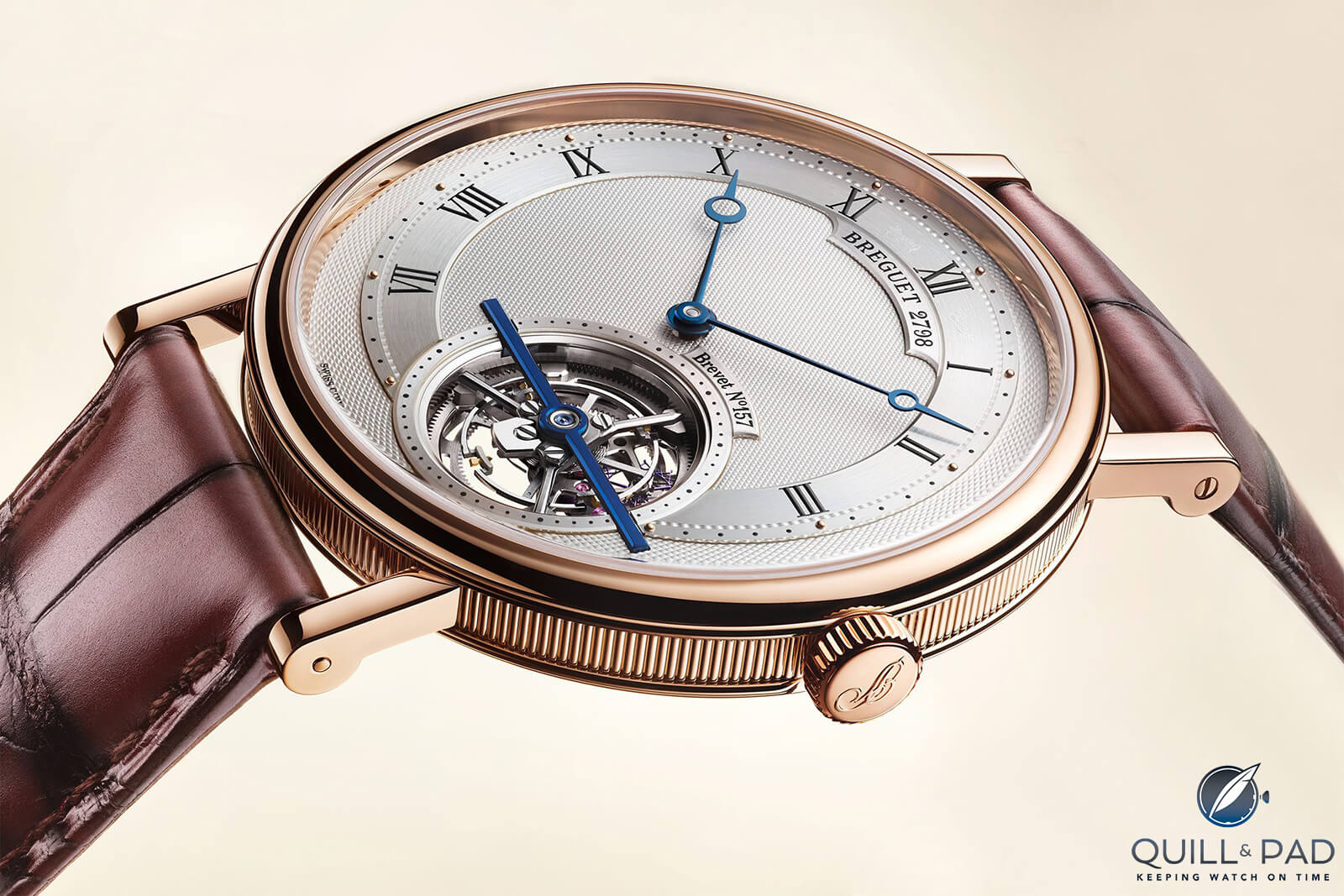
Breguet Classique Tourbillon Extra Plat Anniversaire Ref. 5365
This resulted in knock-on benefits including being able to form legible dials showing chapter rings, small-seconds and power-reserve indicators that would all eventually end up being used by Breguet. The final two inventions I want to touch on are the Breguet balance spring and tourbillon.
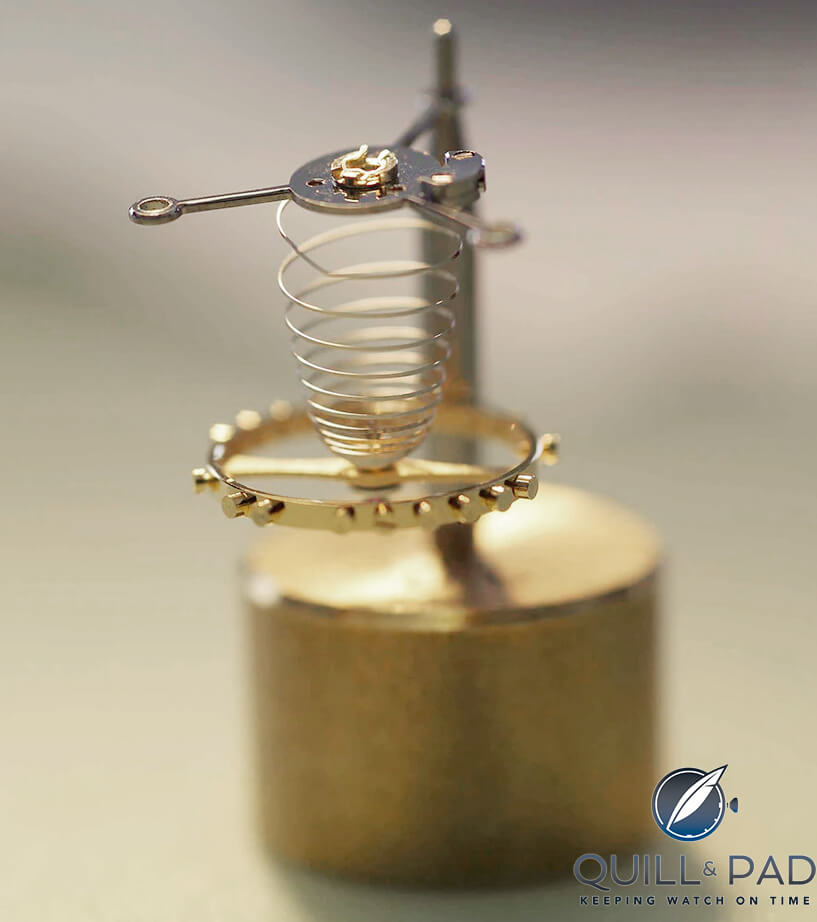
Poising a Breguet balance spring
The balance spring was nothing new at the time as the first flat balance spring was invented in 1675. However, there was still room for improvement as precision was less than ideal and they struggled with wear and tear. Breguet solved this problem in 1795 by bringing the outer of the spiral towards the center following a precise curve. This led to the form of the balance spring we on many fine watches today and improved both the longevity and accuracy of the movement.
Other brands followed, with early adopters up to 1910 still inscribing their balance springs with “spiral Breguet” or Breguet overcoil” for credibility.
Finally, the tourbillon. Arguably, one of the most coveted movement complications. Breguet was extremely capable when it came to mathematics and physics, understanding that the position of a watch led to variations in movement accuracy.
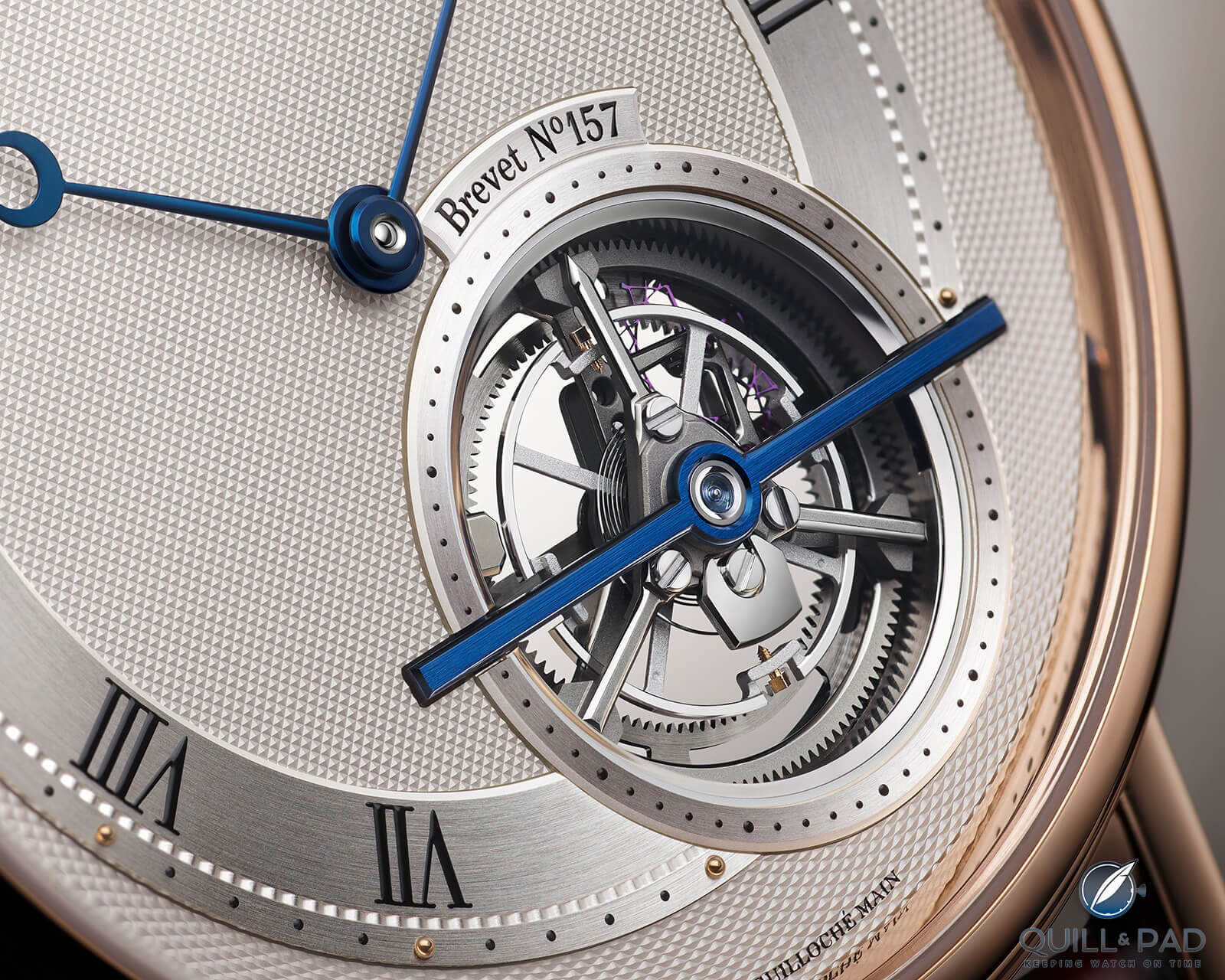
Tourbillon of the Breguet Classique Tourbillon Extra Plat Anniversaire Ref. 5365
Pocket watches at the time were typically kept vertical (no surprise, they were kept in pockets!) and Breguet knew this was due to gravity distorting the balance spring. Obviously, offsetting gravity itself is not possible, so Breguet developed a mechanism that rotated the escapement about an axis once a minute. Thinking about how this works in 2023 is impressive let alone in 1801!
Several more inventions Breguet produced include off-center dials, keyless winding, and a constant force escapement. It is no surprise that the clientele of Breguet at the time were some of the most notable people in Europe, including royalty.
Breguet, the brand, was passed down to the decedents of Abraham-Louis Breguet and kept within the family until 1870. It was then sold to Edward Brown, a partner in Breguet at the time, and remained under the British family for just over a century.
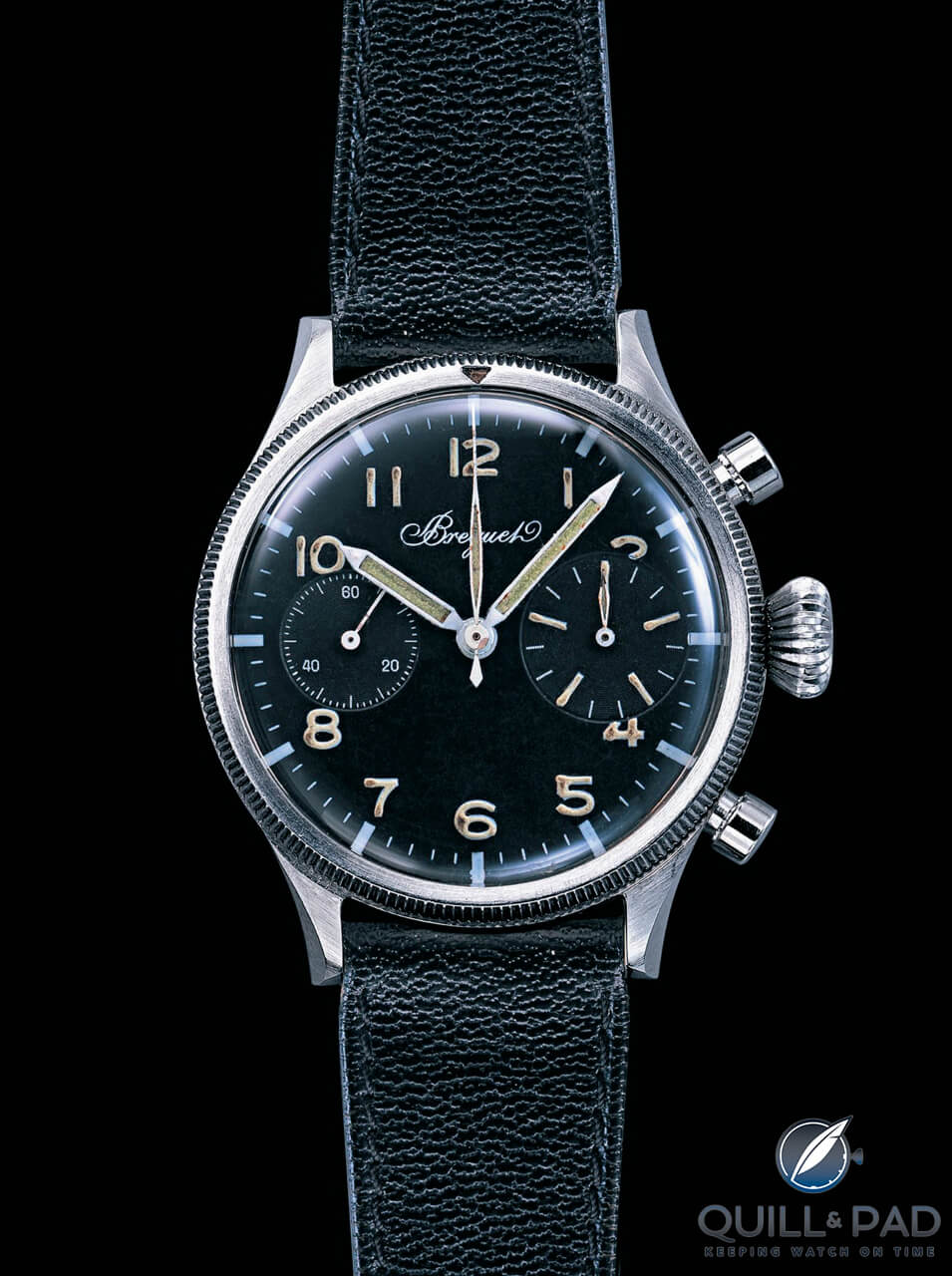
Breguet Type XX from 1954
During that time, the most notable release was the Type 20 (Type 20 denotes the models for the military and Type XX were those made available to the public) in 1954 when the French Ministry of Defense was looking for a chronograph for its Air Force. The Type XX range remains part of the current Breguet collection in 2023.
Eventually, Breguet was sold to the Paris-based Chaumet brothers who came from a family of jewelers. In this period, Breguet moved to Le Brassus, a village in the Vallée de Joux, Switzerland. Daniel Roth, a notable watchmaker, was brought in and the watches produced became more reminiscent of the original Breguet pieces. Guilloche dials were brought back, Breguet hands were widely used, and the tourbillon was put into a Breguet wristwatch.
This period ended abruptly in 1987 when the Chaumet brothers were forced to sell. Between 1987 and 1999, the brand suffered. Quality dropped and the brand could not keep up with the other top watchmakers such as Patek Philippe. In 1999, Breguet was acquired by Nicolas G. Hayek, the founder of the Swatch group. As of 2023, the brand remains a staple under the Swatch Group umbrella. And it has regained some of its prior glory.
Why Are Modern Breguet Special?
The history behind Breguet is vast and that is one of the factors that makes Breguet so compelling today. However, as I mentioned at the start, there is still a lack of appreciation for the current pieces, so let us consider a few areas of modern Breguet that highlight just what is on offer.
Dial
As with any brand, Breguet has multiple dial designs on offer that range of styles, yet the attention to detail remains consistent throughout. One thing you will notice about Breguet is they focus on strong, yet simple, designs. Legibility was at the heart of what drove Abraham-Louis to use guilloche finishing on the dials, as well as the ability to create artistic patterns, and that tradition continues today.
It is so vital to Breguet, that they have previously referred to their expertise in this area as their second artistic craft after watchmaking.

A few of the rose engine guilloche team at the Breguet manufacture
The hand finishing is done by a dedicated that works using restored antique rose engine-turning machines. The finishing is applied to sections of the dial, case, case back and movements with designs created in-house that are innovative and provocative beyond what you would naturally imagine of a guilloche pattern. The result is quite simply beautiful.
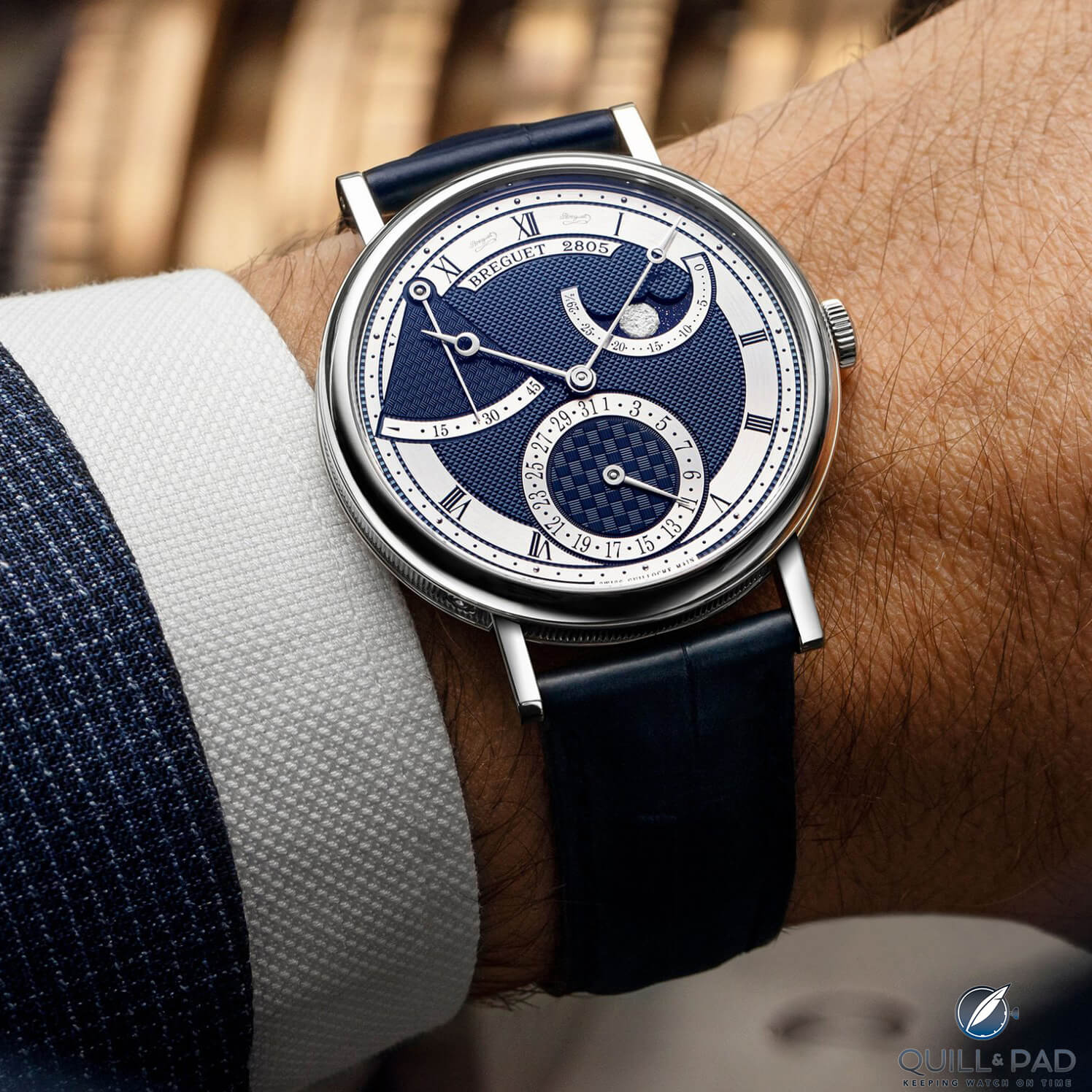
Breguet Ref. 7137BBY59VU on the wrist
Breguet can add complications to the dial such as a power-reserve or small seconds dial and clearly distinguish between them with just the use of finishing difference.
Again, maintaining the philosophy of legibility and beauty. Even those time-only variants benefit as the center of the dials are found this way, with the outer chapter ring left brushed. What this all achieves is simple-looking watches that on closer inspection have an extraordinary amount of depth. I should say, not all dials are made this way, as there are references that use oven fired enamel (done in-house), but the design characteristic remains consistent.
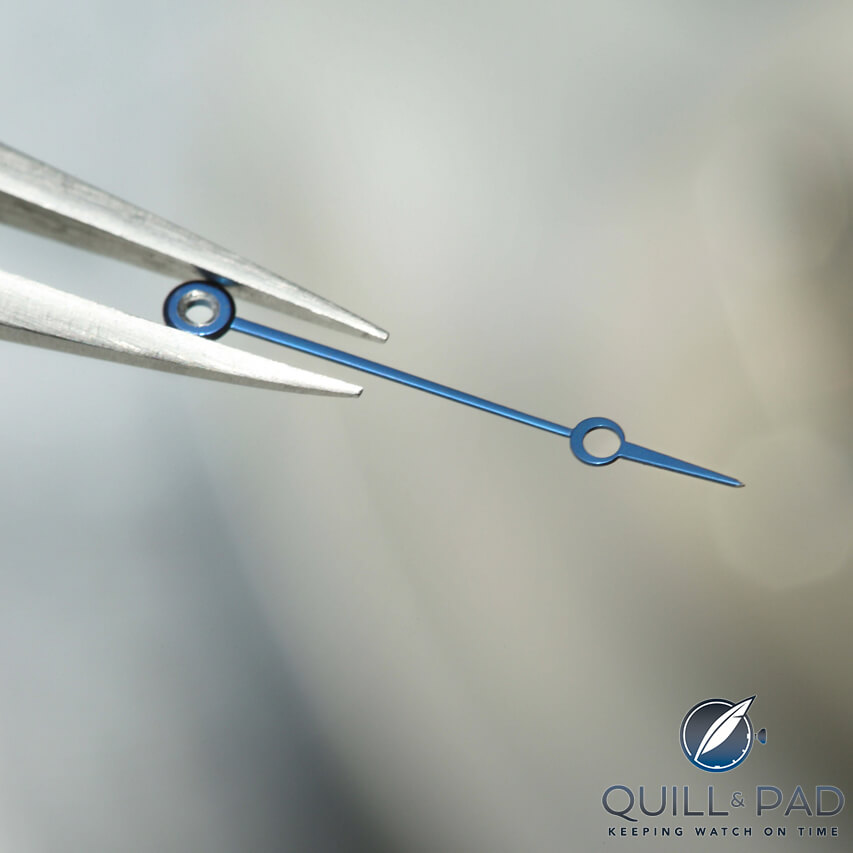
Iconic blued steel Breguet hand
Beyond the guilloche finishing, Breguet continues to use other elements from its past on the dials today. The Breguet hands are a clear example, featuring the hollow moon tip as well as the classic Roman numerals found on most models apart from the Type series and Reine de Naples. There will be small differences and intricacies across different dial variants, but I’ll use the time-only Classique to help highlight a few of the finer details that you can come to expect from the brand.
The chapter ring is brushed and surrounded by a different guilloche pattern. The minute markers are perfectly positioned black dots with every five-minute marker being applied gold. As with all Breguet models, the dial has the hallmark characteristic of being numbered. This is something Breguet has always done as a nod to the artistry, craftsmanship and time behind each watch produced.
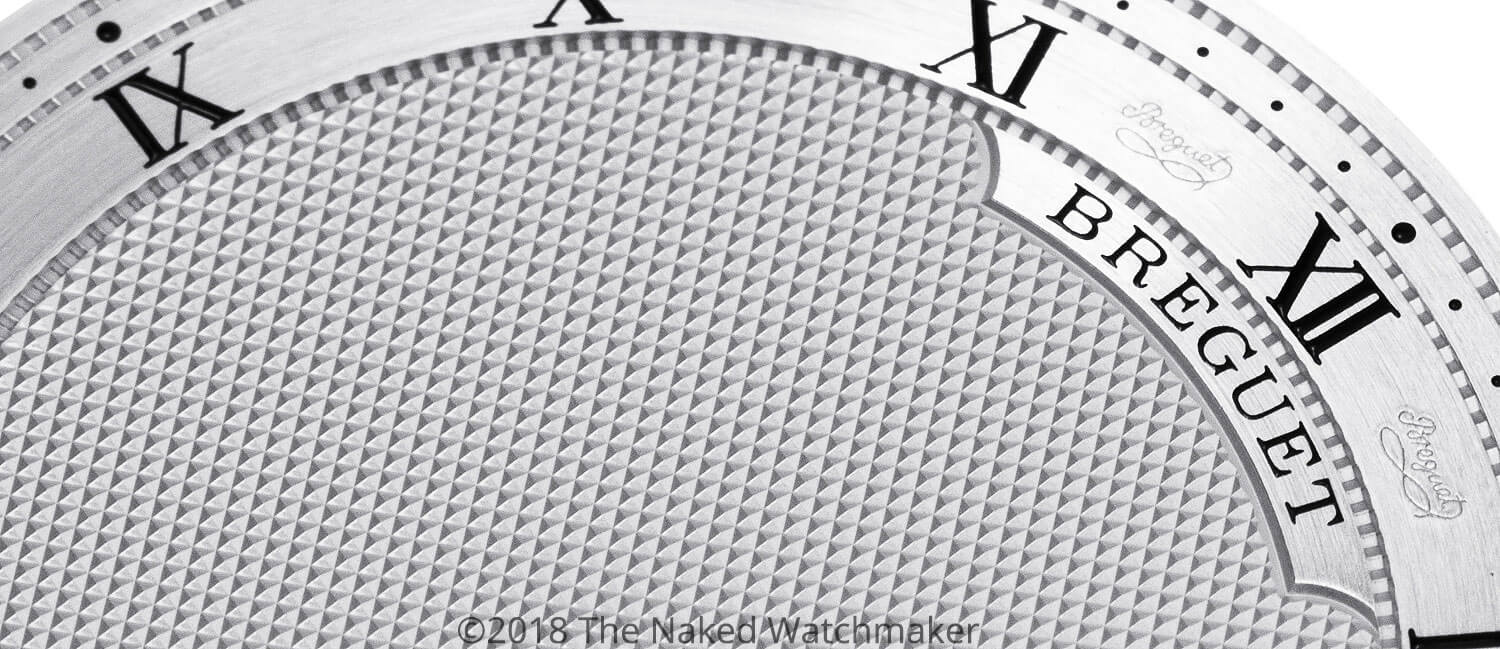
A-L Breguet introduced his secret signature to help foil fake copies of his watches (which was already a problem two hundred years ago)
Similarly, Breguet continues to use its secret signature on the dial. As Breguet became popular in the past, counterfeits began to appear, and Abraham-Louis Breguet wanted to find a way to oppose this. He did so by engraving a barely visible “Breguet” signature into each of the dials that can only be seen when the light hits in a specific way.
Case
Breguet offers numerous models in its current collection with different case shapes. What defines Breguet though has nothing to do with anything that immediately stands out in terms of case shape. Rather, it all comes down to case refinement. When looking at a watch, the dial is where we look first, this is how we interact with it after all, but the more time you spend with a watch, the more obvious case execution and finishing becomes.
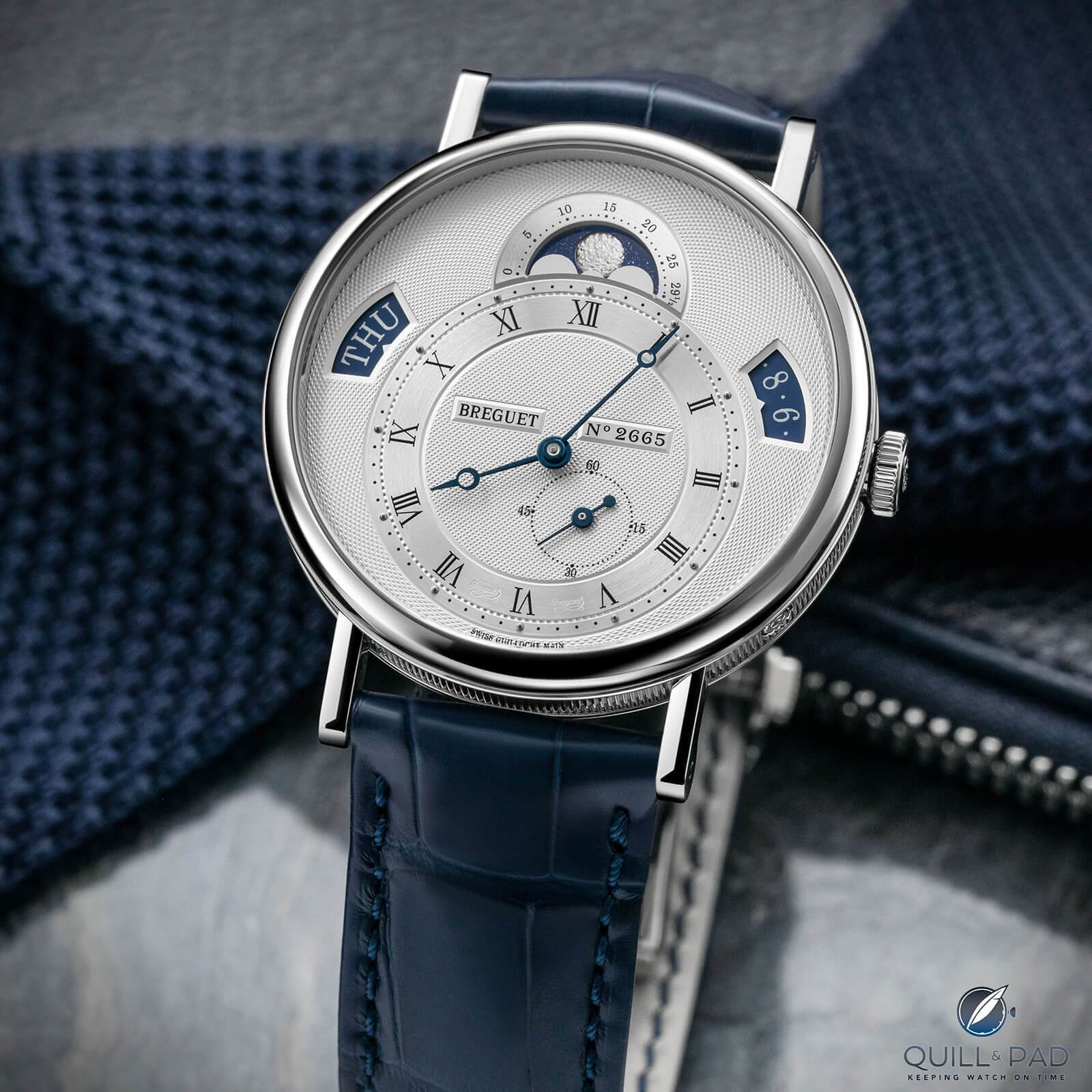
Breguet Ref. 7337 triple calendar
When you start looking beyond the external aesthetics, you notice the case details and a watch with an appealing case can make all the difference.
Breguet cases, in most instances, are a nod to their past, featuring a fluted, coin-edge central pattern along the sides. This pattern is cold-rolled into the case and then finished by hand. This can be subtle detail if you are considering a Classique model but also prominent on the Type and Marine. I should highlight, that this is even found on the titanium models despite the alloy being challenging to work with.
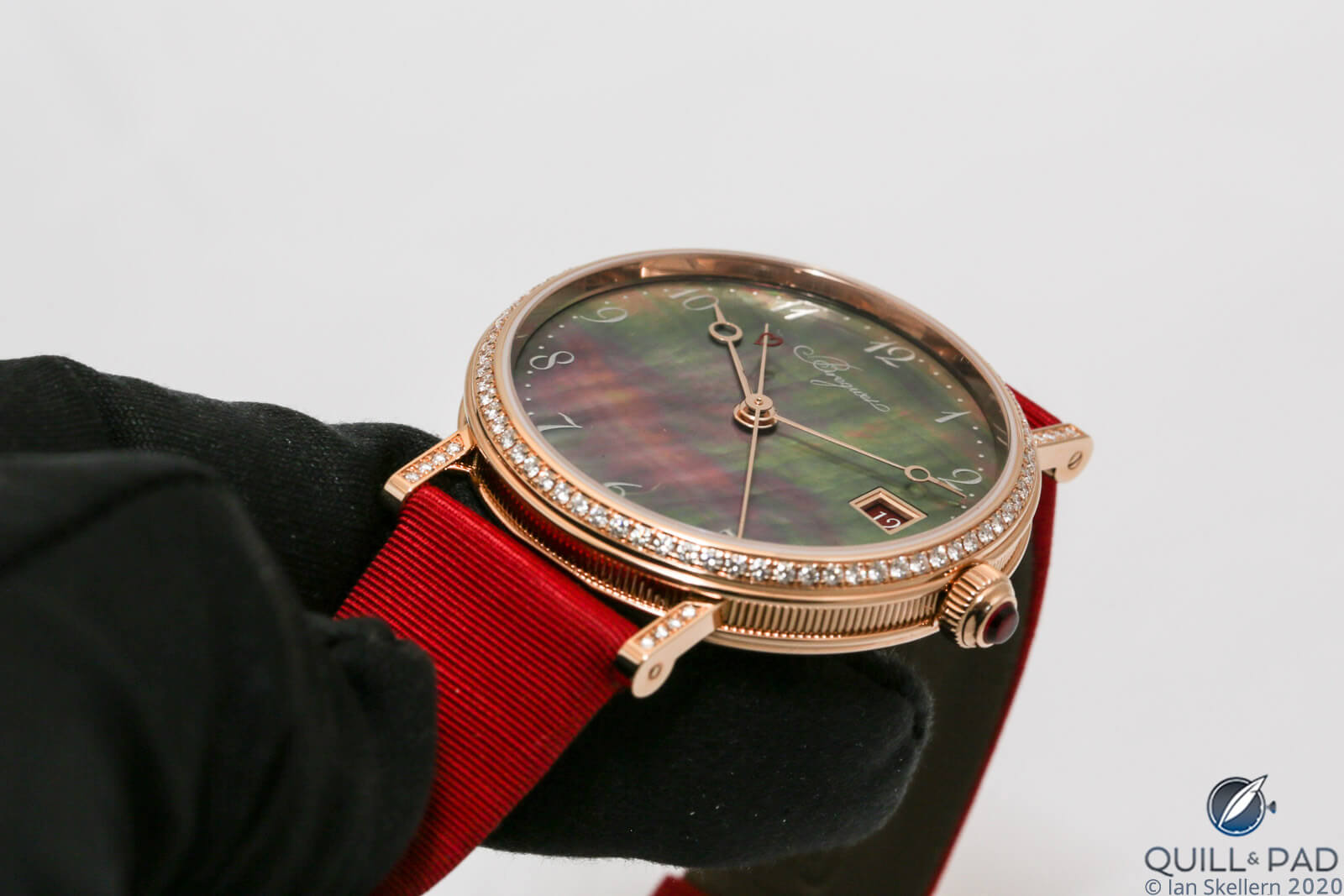
Breguet Classique Dame Reference 9065
The fluted pattern is encased by a polished raised lip, which then leads into a relatively thin polished domed bezel (except for the Type series). The bezels are relatively compact, giving maximum visibility of the dials – it could be argued they are bezel-less watches.
The lugs are typically straight with a slight curve at the end and use screw pins instead of spring bars. These provide more security in holding the strap in place. The lugs themselves are welded into the case so do not disrupt the fluted finishing. Again, this is all done by hand.
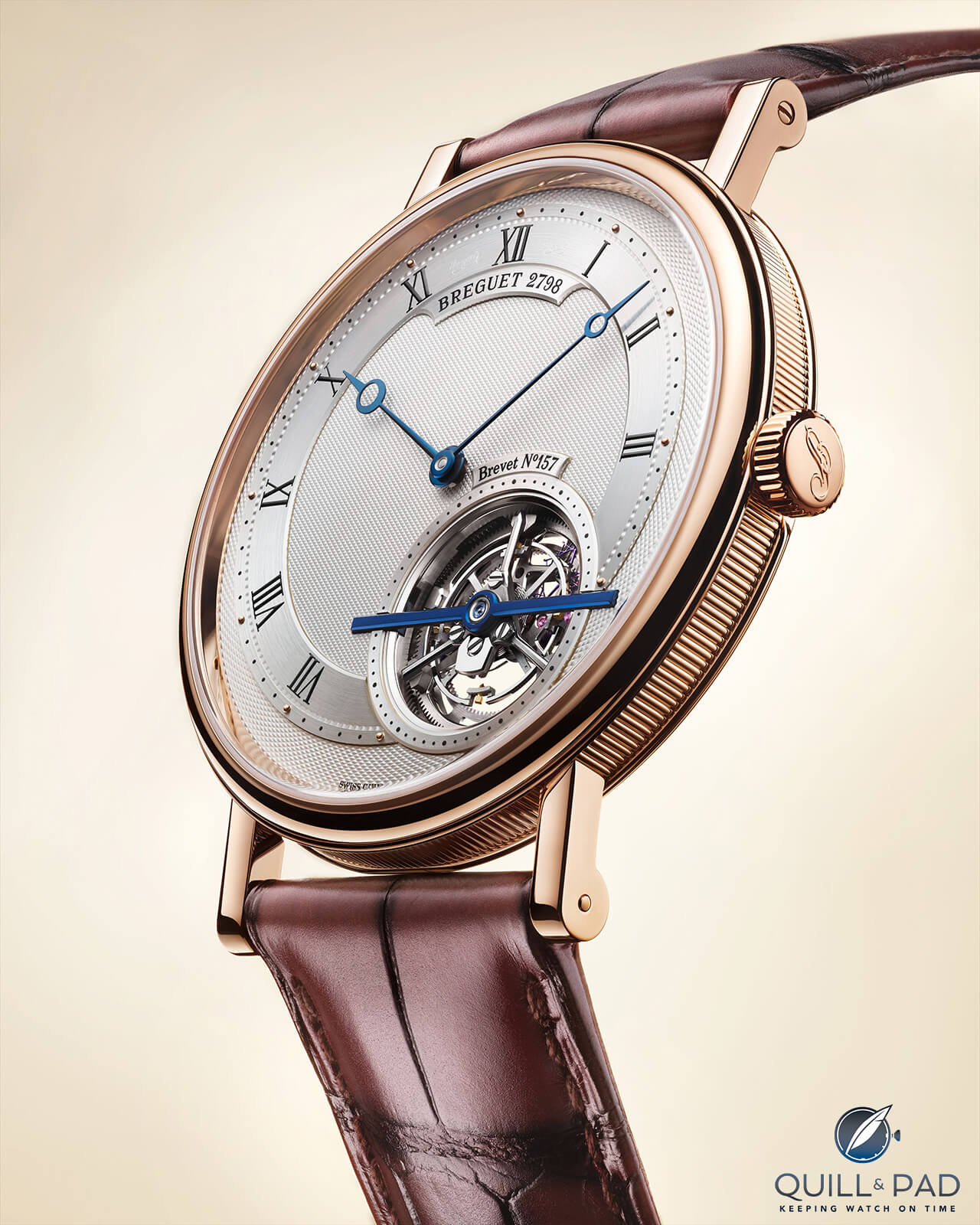
Breguet Classique Tourbillon Extra Plat Anniversaire 5365
The crown features a simple Breguet “B”. The result is a unique experience as the fluted edges capture and reflect light pleasingly. This is then further accentuated by the polished lip and domed bezel, resulting in a case that has depth and complexity in what would otherwise be an understated, minimal package.
Movements
Breguet produces all its own movements in-house. There are a wide range of complications on offer, ranging from time-only, retrograde seconds, chronographs, and Tourbillons (and more). It is not the movement engineering that I want to focus on here, but rather the movement decoration and architecture. Those same standards that we see on the case and dials are held throughout the watch, regardless of whether you can visibly see them.
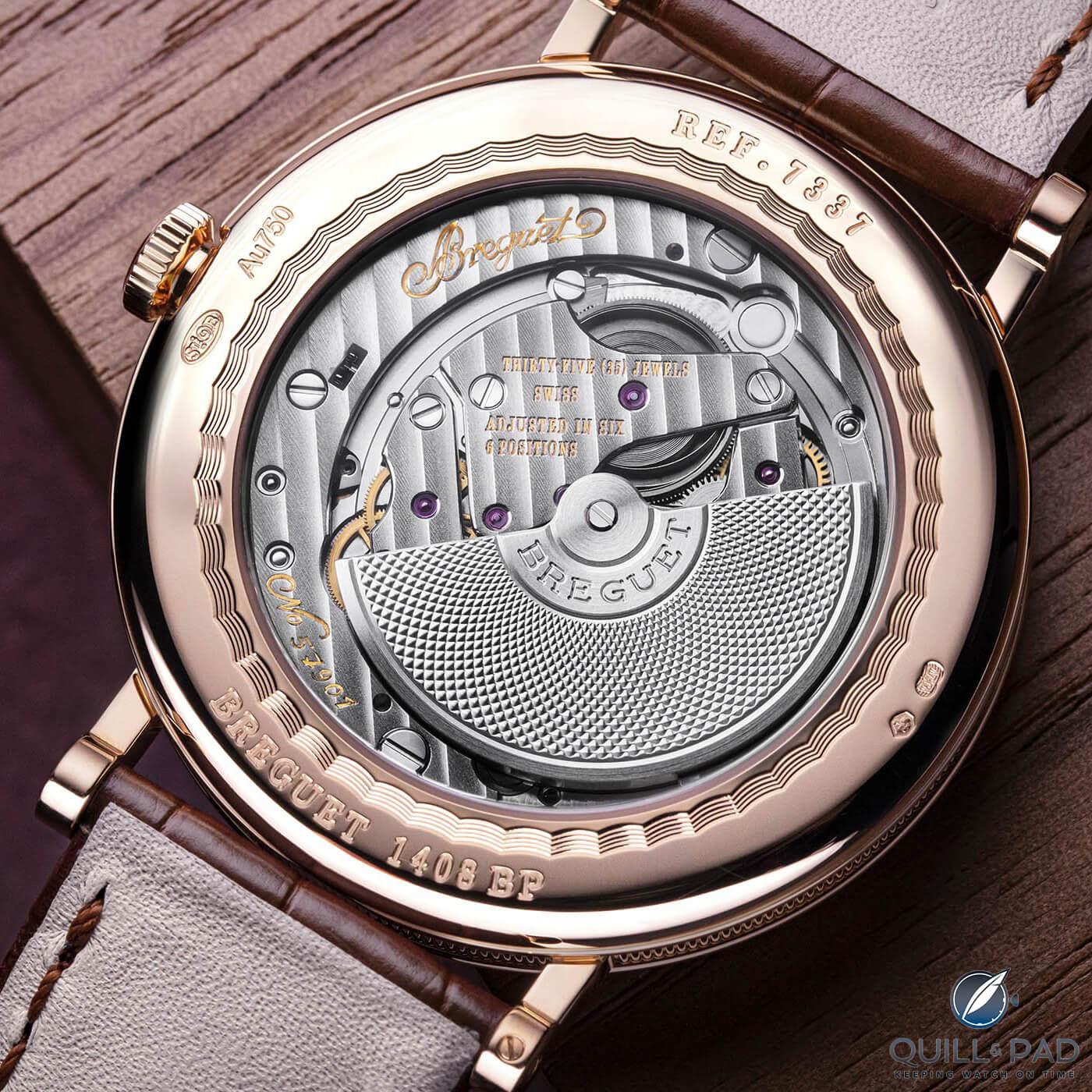
The guilloched rotor of the Breguet Classique Ref. 7337 Calendar and Moon
This is not something new to the brand as you can see this aspect even on those first watches produced by Breguet. Turn over a Breguet and you will find a combination of polished bevels and engravings.
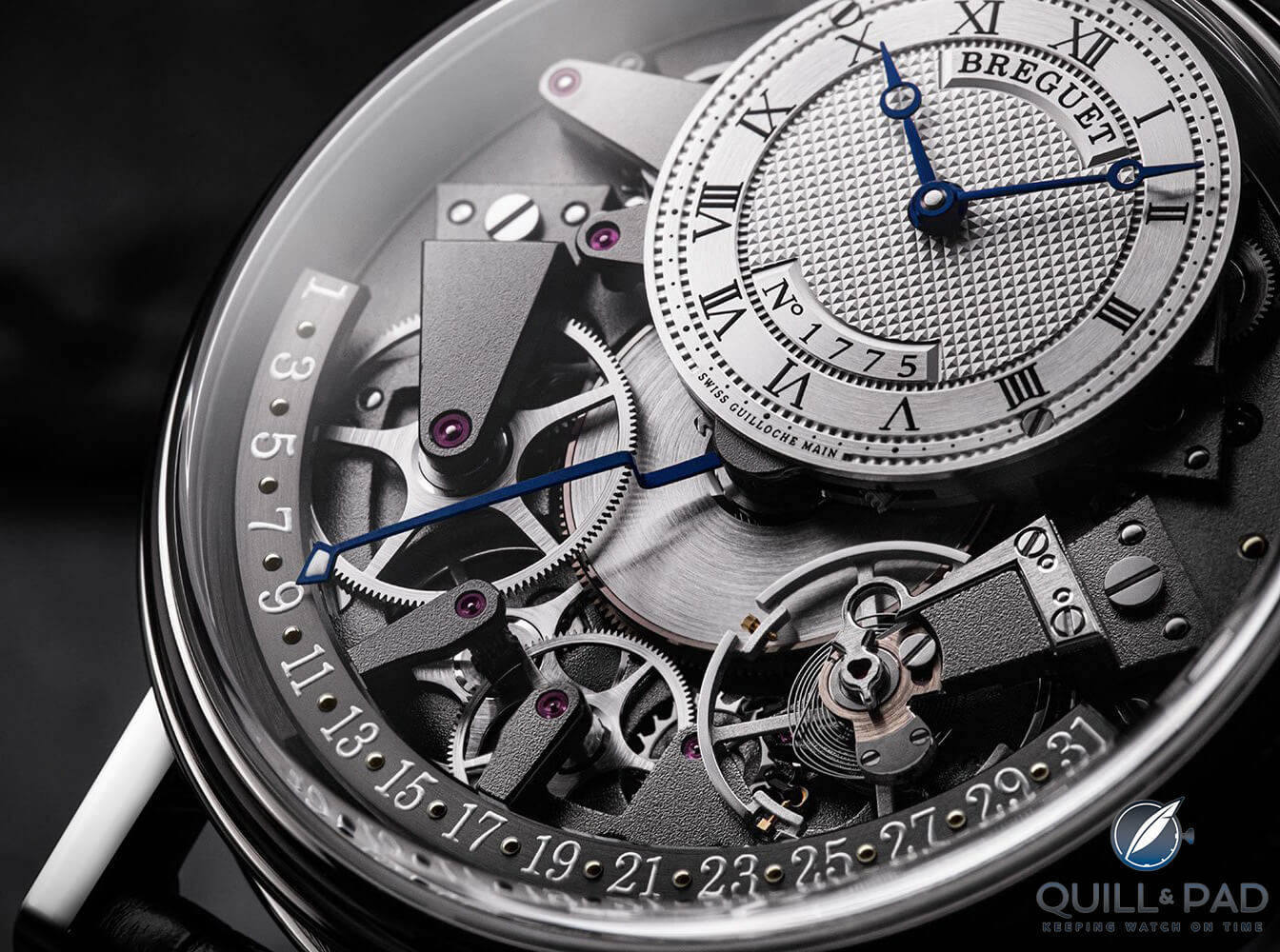
Breguet Tradition Ref. 7597BB
What I find particularly appealing are the off-centre rotors or anchor-shaped rotor that is inspired by the first Perpétuelle in some movements. Then there is the open-worked Breguet Tradition where the movement is essentially the watch, with the architecture echoing the souscription watch in 1795.
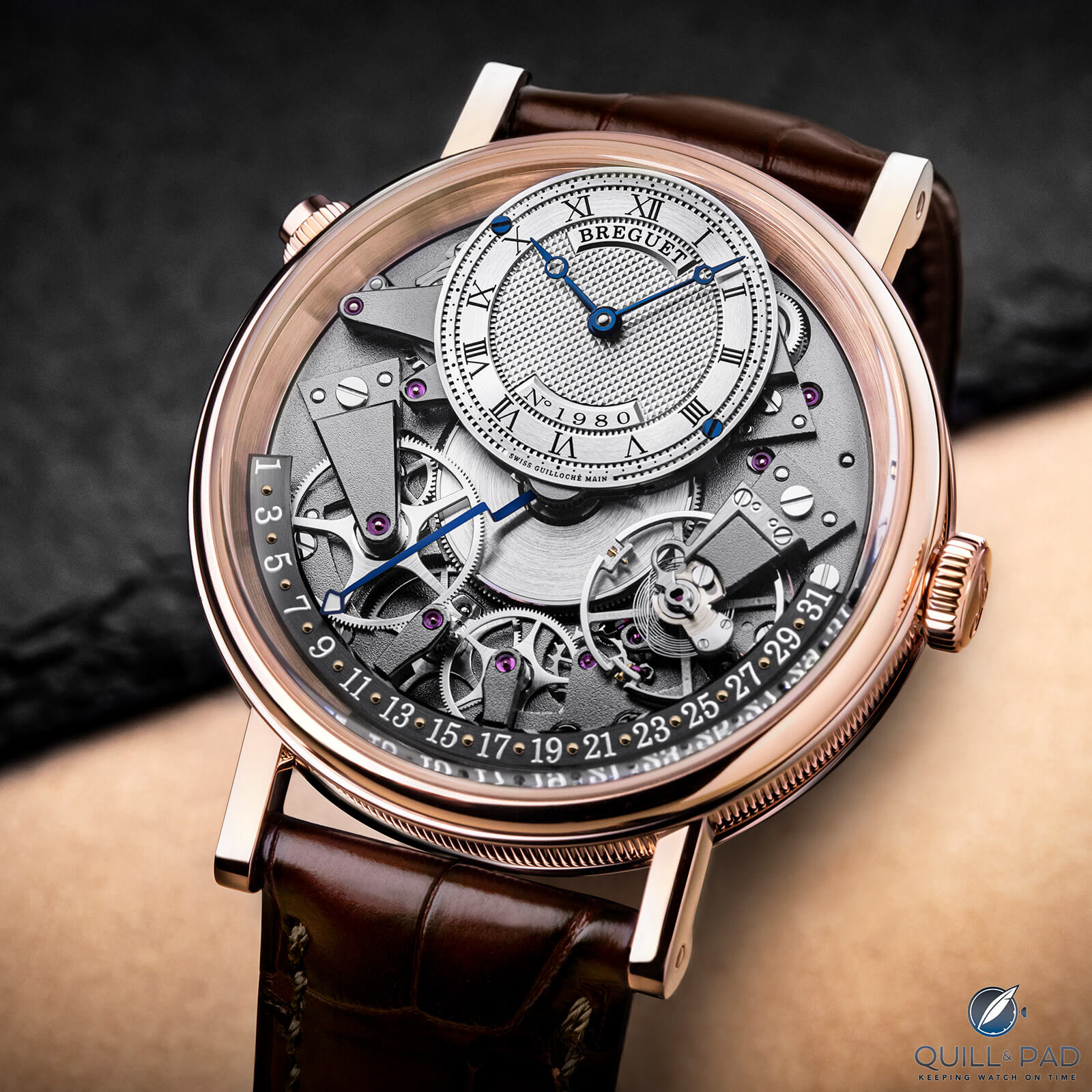
Breguet Tradition Quantième Rétrograde 7597
The dial is perfectly balanced, and the movement is made using anthracite. This gives the overall watch a matte, dark grey finish that allows elements of the movement such as the escapement or complications such as retrograde seconds to stand out. Once again, building on the Breguet philosophy of artistic finishing but legibility. These small quirky details add even more personality to the Breguet pieces.
Breguet has been at the forefront of innovations in the past as we explored above, and this continues today. Since 1999, there have been further contributions to watchmaking. They launched the magnetic pivot, which is a shock-protection device using magnets surrounding the balance to help with accuracy.
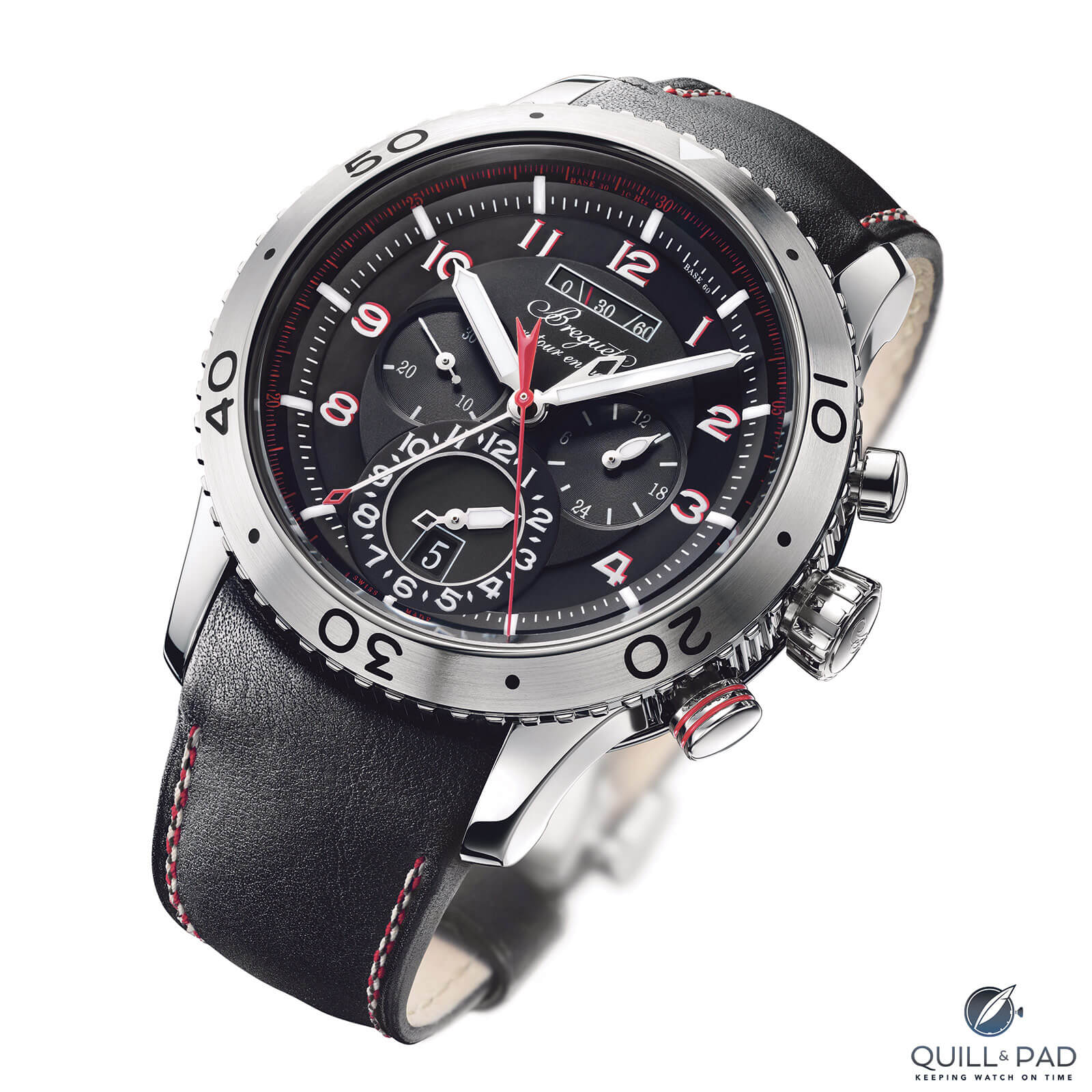
Breguet Type XXII Reference 3800ST from 2010
They launched the Type XXII (ref. 3880 ST) in 2010 which was the first and only mechanical chronograph to run at a high frequency of 10Hz. This was achieved by developing a high-frequency silicon balance spring, lever, and escape wheel, making it possible to read 1/20th of a second when using the chronograph.
And don’t forget that before being able to produce a high-frequency version, Breguet needed to develop the silicon escape wheel and lever that came a few years before the Type XXII.
Breguet is very much connected to its past but that does not stop it from being one of the watchmakers still pushing forward the industry today. Behind the classic aesthetic lies a great deal of modern innovation.
Why Has Breguet Fallen Behind?
Given all the above, it can be a surprise that Breguet has fallen behind other top brands. The formula is there for Breguet to succeed. They pack ample amounts of emotion into each of their watches and have all the history you could ask for when making a product emotive. Why then, is this not translating into broader interest for the brand? In my opinion, it is a result of two factors: society becoming more casual and the rise of social media.
This probably does not need pointing out, but in recent times there has been a wider trend of society becoming more relaxed (at least on the outside). This was already happening slowly before 2020 which saw the rise of tech firms normalizing new standards for professions that had historically been more formal. Suits became an attire for business meetings, but day-to-day fashion saw the uptick of chinos and shirts.
Office spaces were renovated to make the environment more appealing. With the global Covid-19 pandemic, many jobs had to shift to a remote setup, speeding up this trend. Clearly, this was not the case for everyone, and I want to acknowledge that, but this was what society experienced even if individually we felt differently at the time.
This shift could be a factor influencing the changing demand for watches. There was always an interest in sports watches, especially stainless steel variants, but to say demand exploded is an understatement. For some time, even before Covid-19, it was not just acceptable to be wearing a larger diver to work, it became the standard.
In addition, as work environments became more casual, the aesthetics of a sports watch looked less out of place. These watches also provided a level of versatility. You could be wearing one with smart casual or a suit, as well as on the weekend for whatever you were doing.
Further to this, the versatility appealed, and still appeals, to those who were interested in wearing something that could work for all occasions. Ultimately, this is why this category is still so popular and the entry for most.
Breguet, with its neo-classical design philosophy, was impacted by this trend. Aspirations for dress watches started to turn. Why are Patek Philippe, Audemars Piguet and Vacheron Constantin able to manage and thrive? They all have sportier models in their collection and luckily for all of them, they are the coveted integrated bracelet models.
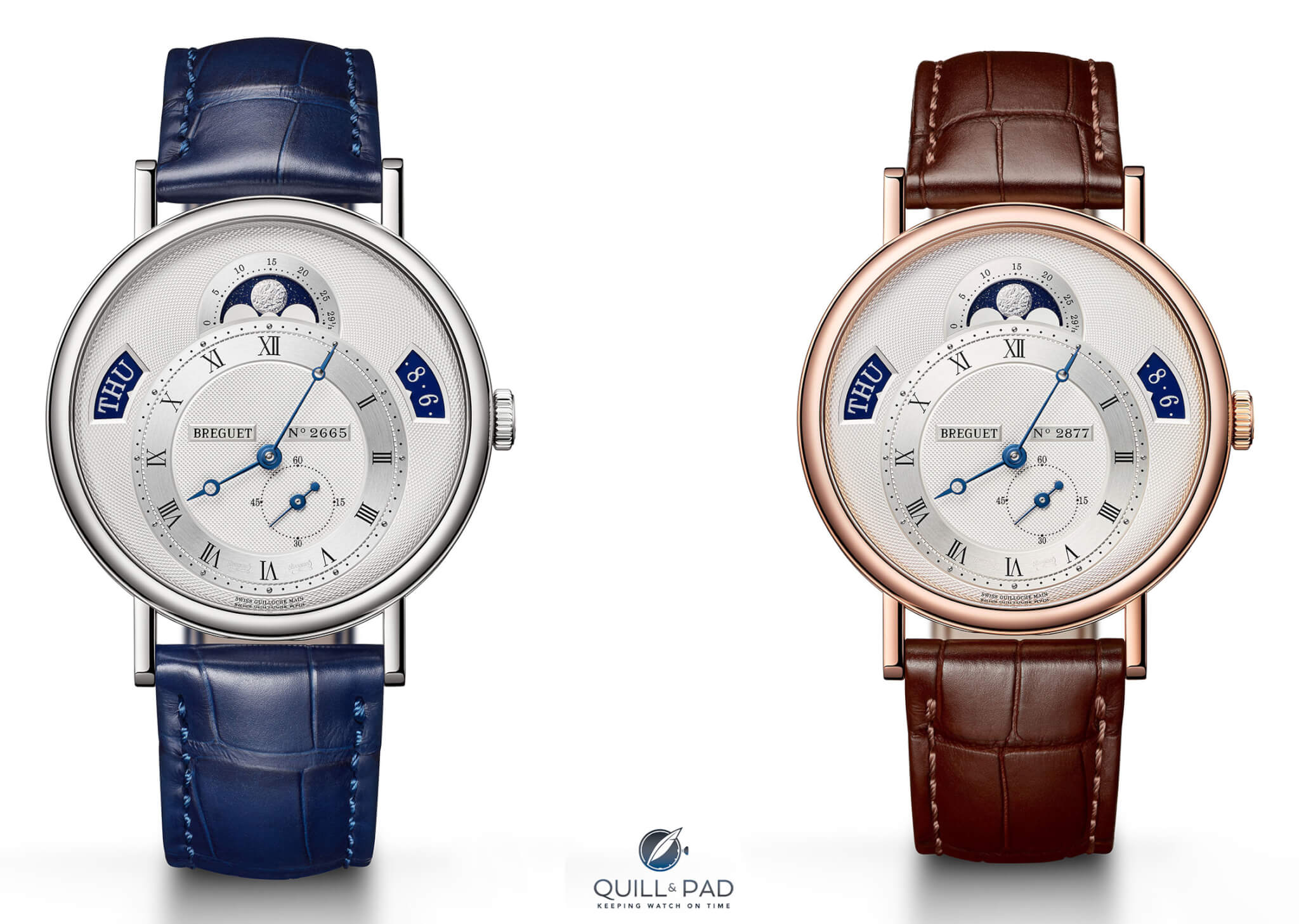
Breguet Classique Calendrier Ref. 7337 in white gold and pink gold cases
Breguet is a champion of dress watches and tradition. The Roman numerals, svelte Breguet hands, straight lugs, and lack of versatility for most models all went against the broader consumer demand. Even their Marine dive watches hold a lot of these features.
In addition, there is the impact of social media. This is a supplementary point to the one above. The emergence of social media coincided with the appeal and interest in watches growing. I have discussed this in other articles of mine but with the likes of YouTube and Instagram, accessibility of information surrounding a particular brand or model grew massively.
You no longer needed to walk into a boutique to discover more or go down the rabbit hole of watch forums. This spread of information though was and is not always uniform. One watch, or type of watch, may get more attention than others. By doing so, it creates a further desire to own these pieces.
It is not the case for everyone, but buying a watch has a certain degree of social status attached to it. In this sense, these watches garnering high interest become the “it” item to have, further pushing demand. Breguet has not fallen into this bracket.
Now, you could argue this is down to scarcity as Breguet is a more niche, low-volume brand compared to the likes of Rolex, although it is also a result of the fashion which has not lined up with Breguet aesthetics.
The two points above are my opinion on why Breguet has not risen in line with some other brands, despite being technically in line (and exceeds compared to the likes of Rolex) when it comes to finishing.
Are We About To See A Breguet Comeback?
I believe we might be about to see a Breguet comeback. Clearly, they are great watches. In May 2023, many Breguet pieces are available at compelling prices. The Breguet Tradition, my personal favorite, is trading below retail prices on Chrono24 in ‘new’ condition.
The Breguet Tradition trades below a stainless steel Rolex Daytona – just let that sink in. Clearly, the attractiveness of current pricing is one obvious aspect, but why might we see Breguet’s interest rise now?
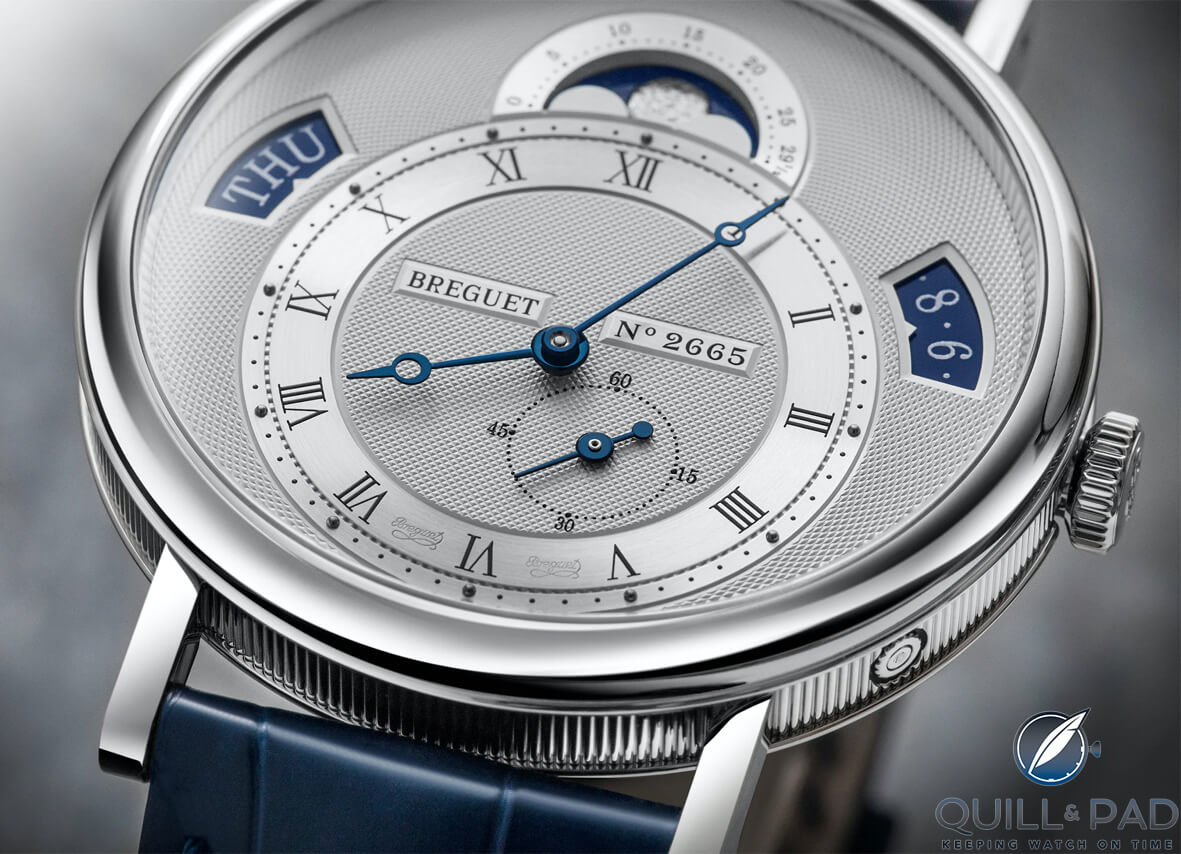
Breguet Ref. 2665
I have said this before, I think the dress watch category is due for a resurgence and if that were to materialize, Breguet would benefit. There are a few reasons I think this, and you may have seen it in the Watch Trends article. Excess demand for sports watches has created some high prices, and despite the market softening during 2022, they are still high. As a result of economic times being tougher, you tend to see people become savvier with their spending.
For most, more thought will go into purchasing luxury items and with that, the justification of spending over RRP to beat a waiting list starts to sound even more questionable on a lot of models. This should lead to consumers searching for ‘value’. This is where dress watches would gain. Breguet and others have dress watches in their collection that offer the same access to a brand’s engineering, quality, finishing and movements.
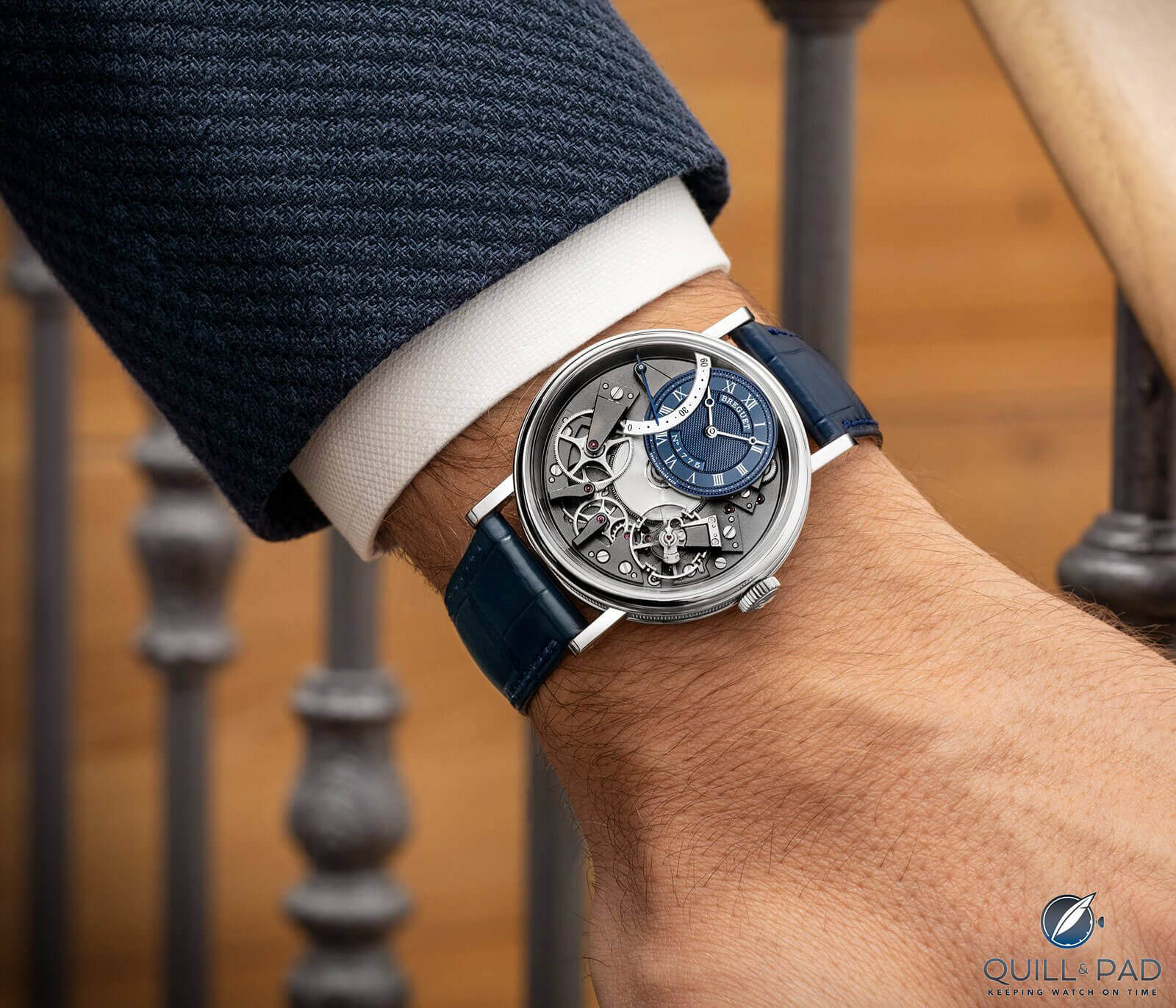
Breguet La Tradition Ref. 7097BB
On top of this, as economic times are challenged, there is a shift towards ‘stealth wealth’. What do I mean by this? Showing your wealth becomes less favorable, whether it be around your colleagues or friends, but also in public. There has been an increase in watch theft in metropolitan areas, which has been widely reported. This factor again pushes the idea that subtly will be in demand and dress watches tend to fall into this bracket.
Beyond this, I believe that there is now a larger consumer base that is looking for something more niche. As certain pieces have become extremely popular, and dare I say common (in watch circles), there has been and will be a shift towards watches that are slightly different.
There is a reason demand began with the likes of the Rolex Daytona and Audemars Piguet Royal Oak, and then spread to any stainless steel Rolex, Patek Philippe Aquanaut (not widely appreciated that long ago) or F. P. Journe for example.
People are on the lookout for the next best thing. Breguet can fill that void. On top of this, those who pride themselves on not following a crowd will be looking for something that is not overly popular. They want something unique. Again, Breguet can fill that void of being a high-quality watch from a low-volume brand that you will most likely not see on other wrists often.
The final point to make builds on the emotional angle of buying a wristwatch. In a world that is extremely digital where progress continues to happen at a rapid pace, there is something to be said about items that can provide a sense of nostalgia. Watches, given their analog nature, all experience this to some degree. Yet Breguet, with all its history being captured in each watch it produces, can provide this feeling even more so.
This is not to say there are no other watches that can, but it is an aspect behind consumers’ decisions and tastes – just look at the rise of vintage-inspired pieces being released by all brands. Breguet is able to do this naturally. It is in their DNA. Their design philosophy has been around longer than most brands altogether. As we search for items, even beyond watches, that manage to capture a sense of the past to remind us of simplicity, Breguet is perfectly positioned to cater to those needs.
This is all assuming that the current collection remains the same. Who knows, Breguet may look at launching something new which could speed the interest in the brand up. But in the meantime, I do believe this change may come.
Conclusion
Breguet is one of the most historically rich brands and has a claim to many innovations within watchmaking. When buying a wristwatch, emotion is a large part of the process. Given Breguet looks at its past to help define its current collection, it manages to capture that emotive angle.
Whether it be the use of Breguet hands, traditional hand-produced guilloche dials and cases or having the open-work dial of the Breguet Tradition resembling their old pocket watches. Unfortunately for Breguet, the exponential rise in interest in watches has been focused more on sports watches, coinciding with the casualization of society.
For now, this results in some very attractive pricing of Breguet pieces, but in my eyes, I don’t think this will last. I can see how as the world moves forward from Covid-19, people become more engrained in watch collecting and looking for niche pieces, and Breguet will return to the spotlight.
After all, the refinement of Breguet’s watches is something to behold. Maybe it is time to beat that train and look beyond the popular big-name brands and models everyone is still focused on!
For more information, please visit www.breguet.com
* This article was first published 01 September 2023 at Is Breguet Ready for a Comeback? And if so, How?
You might also enjoy:
The Breguet A2: It Does Up To 40 Kilometers Per Hour And Doesn’t Tell The Time
Emmanuel Breguet Talks Fakes In The Time Of Abraham-Louis Breguet And Much More
Leave a Reply
Want to join the discussion?Feel free to contribute!



You are acting as an apologist for the trust fund babies. Breguet would do better if it could find itself under different leadership. This has hardly anything to do with dress watches falling out of favor. Can you imagine if Stern and Patek Philippe took the reigns of command. How long would it take until Breguet was restored to an elite status? But then, like Patek watches, there would ensue a hike in pricing with an unavailability factor.
Thank you for this very good article.
Kindly allow me two follow-up questions please:
You write that between 1987 and 1999, the brand suffered and quality dropped. Could you elaborate more on the underlying reasons for this, what criteria you used to assess that drop in quality and whether this drop was observed across all Breguet watches at the time or just the Type 20/XX line? (Personally, I think that period also had a positive which is Breguet’s1992 purchase of movement maker Nouvelle Lemania, without which Breguet would not be able to say today that they have in-house movements.)
I wonder why the movement finishing on Breguet watches is typically slightly less sophisticated than on Blancpain watches of a similar price point when Breguet is supposed to sit above Blancpain in the Swatch Group hierarchy? A case in point for my observation is my Blancpain Fifty Fathoms‘ 1315 movement which has gorgeously wide and rounded bevels and the new Breguet Type 20/XX which has not very well finished bevels (which was why I ended not buying it).
I’d be happy to hear your thoughts and learn more about Breguet 🙂
Is the conclusion wait for the sports watch trend to pass, hoping the masses stop chasing (paid) celebrity arm candy – great play Hublot/AP – or what they can’t easily get – kudos Patek/Rolex – and stumble upon Breguet in a ‘look how vintage this looks’ moment that goes viral?
Surely the key is to take inspiration from the eponymous founder, not in terms of aesthetic but in pioneering innovation and new levels of quality.
Let’s hope the answer isn’t a Swatch Traditional!
I think a Swatch x Breguet Traditional would be the hit of the year 🙂
Regards, Ian
It might be fun but given the hierarchy the price (est £500) would be difficult to justify. Not sure how it impacts the real thing costing 100x as much either.
I’m considering both new Fithy Fathoms and the swatch version so who know.
All the best, Ed
“In 1999, Breguet was acquired by Nicolas G. Hayek, the founder of the Swatch group.”
^—This was Breguet’s ‘comeback’. Their range of timepieces exceeds Rolex offerings, and rivals Patek Philippe, IMO.
The main problem of Breguet is not the product, is not their philosophy and is not the customer or social media. The main problem is their leadership. Breguet is part of Swatch Group and that is the main issue. The shareholder value of Swatch Group has dropped down within the last 18 month nearly 50%. Their management prefer obviously to present and launch bullshit watches like Omega x Swatch or Blancpain x Swatch. They should better do and look after their real value brands like Breguet. But the Hayek family is far away to understand and realize their mismanagement.